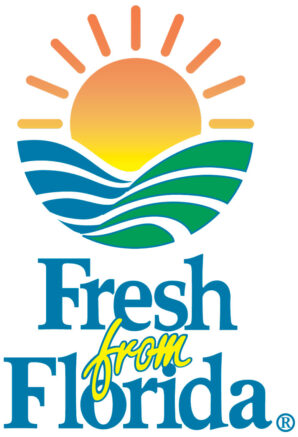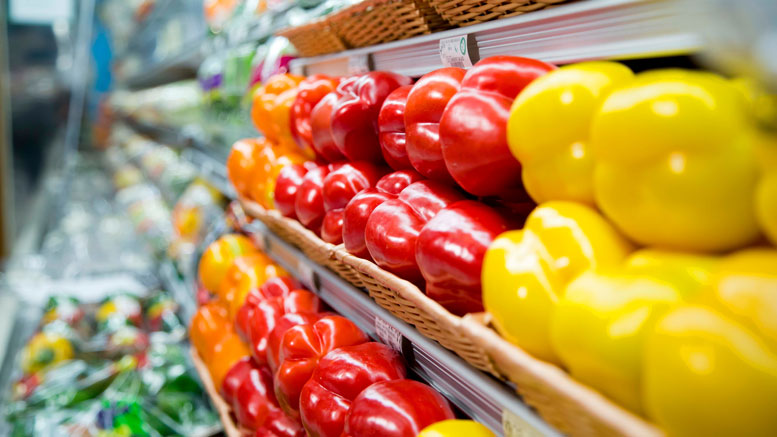Florida offers a wide range of fresh fruits and vegetables in the fall and winter.
Originally printed in the October 2023 issue of Produce Business.
Although a hurricane threatened serious problems, the early outlook for Florida fall produce is solid, so the question of sales is largely of how aggressive produce departments are in the switchover from early to late-season merchandising and marketing.
Christina Morton, director of communications at the Florida Fruit and Vegetable Association (FFVA), says, despite the fears Hurricane Idalia generated at the end of August, only a limited number of growers suffered significant damage.
The area where the storm hit is not a region of heavy produce production, she explained, although a fair proportion of the state had to cope with heavy rain. The timing of the Florida season, running from November to the beginning of summer, and the storm’s particular path both helped assure limited damage.

“While a limited number of growers saw significant impacts in the Big Bend region, much of the state’s specialty crop growers were spared,” reported the FFVA in a statement released shortly after the storm.
FFVA extolls Florida growers as resilient and the best in the world at what they do, and Morton adds they can deal with the bumps in the road that agriculture always experiences.
“As we look to the season ahead, despite a myriad of challenges faced, growers are optimistic and remain focused on bringing fresh fruits and vegetables to the tables of millions of American consumers without interruption,” Morton says. “They are adapting quickly and remaining nimble by innovating, staying responsive to the marketplace and maintaining buyer relationships.”
SEASON LOOKING GOOD
At Alderman Farms, Boynton Beach, FL, which cultivates conventional herbs and organic vegetables, the storm didn’t hit the operation, according to Jimmy Alderman Jr., vice president.
“We’re here in Martin County and Palm Beach County, so we didn’t have adverse effects,” he says. “The season is looking good so far.”
Actually, the main concern right now is about an invasive species of thrips, which damaged Alderman Farms’ pepper crop last year and can affect eggplant. The grower is remaining diligent but, at the same time, hoping the population didn’t overwinter and will be a lesser threat.
Chuck Obern, owner of C&B Farms, Clewiston, FL, which offers herbs, peppers, eggplant, greens, radishes and various cabbages, with some variation between its conventional and organic lineup, says it’s been hot and a little rainy where he grows in South Central Florida, but only enough to be a nuisance. C&B also grows in Baxley, GA, in the south of the state.
“We missed the hurricane,” he says in mid-September. “We’re just getting into our planting season.”
He says the herb side of C&B’s business, which is a big deal for the grower in November and December, should be in good shape, particularly since heavy rainfall in Colombia has created problems for the herb crop there. Softer exports from Colombia should put Florida herb growers in a stronger position.
FRESH FROM FLORIDA
As it does annually, the Florida Department of Agriculture and Consumer Services helps retailers communicate the origins of their produce offerings.

PHOTO COURTESY FLORIDA DEPARTMENT OF AGRICULTURE AND CONSUMER SERVICES
“The Florida Department of Agriculture and Consumer Services promotes Fresh From Florida produce through targeted media and retail campaigns and strategic partnerships,” explains Susie McKinley, director of the department’s division of marketing and development.
This fall, the department is continuing its multifaceted media campaign, she adds. “The campaign is designed to increase Fresh From Florida brand awareness and keep Florida products top of mind for shoppers.”
The connection with retailers is important and FDACS works to maximize the effectiveness of the promotional program, including in stores, using the Fresh From Florida brand.
Retail promotions can be customized and may include a combination of circular ads, in-store announcements, merchandising assets, recipes, social media campaigns and sampling events, McKinley says. “Retailers benefit from 30 years of Fresh From Florida brand awareness when they identify Florida fruits and vegetables with Fresh From Florida signage.”
Retailers can bring some warmth to their produce sections as the weather grows colder by featuring the Sunshine State’s fruit and vegetable abundance, and not just citrus.
“Florida offers a range of fruits and vegetables in the fall,” she emphasizes. “Retailers can merchandise Florida vegetables, such as green beans, squash and peppers, together to create an attractive Florida produce display. Pair Fresh From Florida signage with recipe cards to inspire shoppers browsing the produce department.”

Alderman acknowledges the company and other growers need to do more on the consumer outreach front. Although it attends trade shows to network with folks from the retail end of the business, he says Alderman Farms is not doing “as much as we should” on social media, for example, adding it makes sense to encourage consumers to identify and build a relationship with growers.
Online channels provide a way to do just that — at a time when more people want to learn about the food they eat and where it comes from.
“We have a website and there is a contact section,” Alderman says. “It surprises me how many people check that out. The thing does work.”
Retailers see the greatest results when they feature the Fresh From Florida logo in circulars and merchandise displays, McKinley says. “Surveys indicate Fresh From Florida logo awareness is at 88% and nine out of 10 consumers prefer products labeled with the Fresh From Florida logo.”
In its take on merchandising, Florida FFVA believes identification with the Sunshine State can give retailers a boost given its association with fair skies and good times.
“We would argue it is incredibly important for retailers to identify the fruits and vegetables sourced from Florida, and the Fresh From Florida program is critical to this,” Morton says. “The label signifies to a customer that they are getting the highest quality, freshest produce. For growers, Fresh From Florida is an invaluable partner, providing farmers with resources to market their products to a national and global audience.”
Morton says that the relationship between Florida growers and consumers across the United States is one of mutual benefit.

PHOTO COURTESY PUBLIX
“Just the simple act of placing a priority on buying Florida produce is a win for both growers and consumers,” she says. “For consumers, they know they are supporting Florida growers and getting produce that is of the freshest, highest quality. And for growers, it means having demand for their product that will in turn positively impact the people and communities behind this important industry in the state.”
• • •
Scope of the Florida Produce Sector
According to the Florida Department of Agriculture and Consumer Services, Florida’s 47,500 farms and ranches cover 9.7 million acres and range from the citrus groves and the nurseries in central and south Florida to the vegetables in various regions around the state.
In 2021, the last year for which the ag department has agricultural results available, Florida ranked first in the United States in total floriculture sales and in the value of production for sweet corn, foliage plants for indoor use, Valencia oranges, sugarcane, fresh market tomatoes and watermelons.
Florida ranked second nationally in value of production for bell peppers, grapefruit, all oranges, strawberries and non-Valencia oranges. The state ranked fourth in cabbage, cantaloupe and peanuts.
In Valencia orange production, Florida produced 73% of production in value terms and generated revenues of $411 million. Fresh tomatoes generated $324 million, or 54% of the U.S. total; all oranges, $670 million, or 42% of U.S. value; and sweet corn, $208 million, or 36% of U.S. value.
Watermelon, bell peppers, and grapefruit generated $192 million, $153 million and $72 million, respectively, or 36%, 33% and 33% of U.S. value. Total floriculture sales were $1.11 billion, 17% of the U.S. total value. And strawberries sales were $399 million, or 12% of the U.S. total value.
• • •
Input Costs and Competition Still Hamper Florida Growth
Input costs and import competition are ongoing challenges for fresh produce growers in Florida.
On the cost side, Chuck Obern, owner of C&B Farms, Clewiston, FL, says fuel prices have been up lately and labor is up 15%. Obern has had to rely on H-2A temporary workers, which can draw criticism from some on the hourly rate he can offer. Critics also don’t realize his actual cost is nearly half as much as the hourly wage because of housing and transportation costs associated with workers, he adds.
But some costs have come down, Obern says, including those for fertilizer, certain agricultural chemicals and transportation. He’s concerned, however, that the low prices will drive some transportation firms out of business, causing a significant rebound in prices. Whatever the case, he believes transportation costs will rise at least somewhat when the crops start to move out of Florida in quantity later in the season.
A major challenge Florida growers face is competition from Mexico, Canada, Colombia and other produce-exporting countries that enjoy lower costs than the state’s farmers, he says.
Given costs associated with regulation in the U.S., and resulting competition with Mexico and other countries where labor is only a fraction of what it is in Florida, Obern says it’s important to promote Sunshine State-raised produce and the Fresh From Florida campaign.
“I’ve always been an advocate,” says Obern. “You just have to look at the favorable polls. Most people in America who have a choice will prefer American grown.”
Jimmy Alderman Jr., vice president at Alderman Farms, Boynton Beach, FL, which cultivates conventional herbs and organic vegetables, says some growers recently shut down operations in his vicinity. For that reason, he says, the Fresh From Florida campaign is important.
“It really couldn’t be more important,” Alderman contends. “We battle with all these imports coming in. It’s important for people to know that and buy local. It’s very important to identify where stuff is coming from.”
On the up side, Obern is seeing some U.S. retailers becoming more diverse when awarding contracts — perhaps with a desire to leverage their California commitments in light of weather or other factors that limit supply. Regardless of the reason, it has led to more interest in Florida growers.





